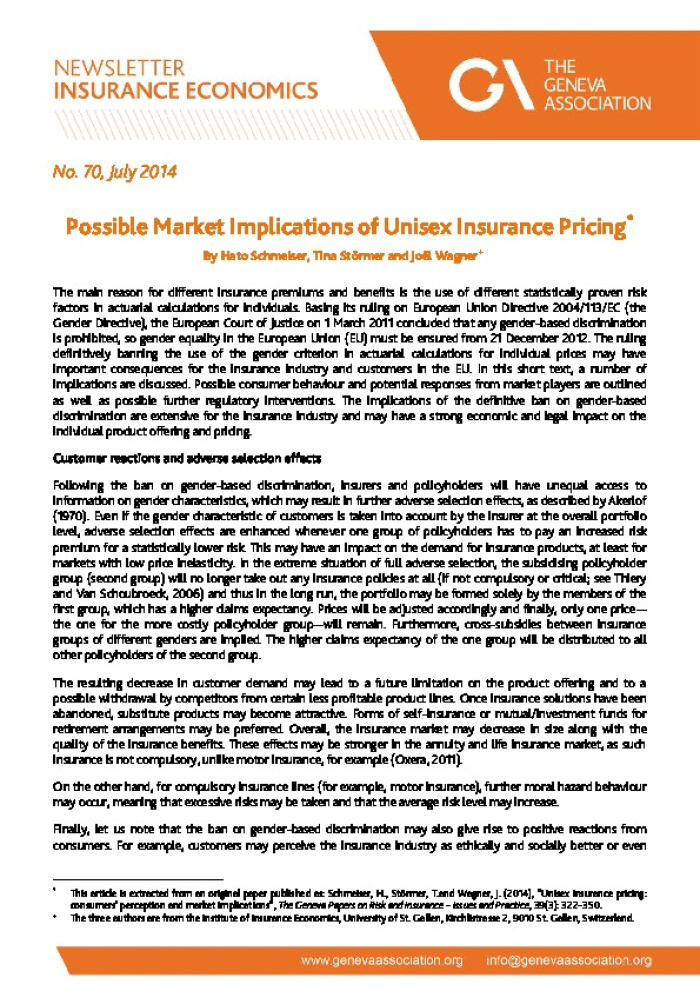Possible Market Implications of Unisex Insurance Pricing
Insurance Economics Newsletter No. 70-Hato Schmeiser et al. look at the recent European Union ruling prohibiting the use of the gender criterion in insurance pricing.

No. 70 , July 2014 Possible Market Implications of Unisex Insurance Pricing* By Hato Schmeiser, Tina St?rmer and Jo?l Wagner+ The main reason for different insurance premiums and benefits is the use of different statistically proven risk factors in actuarial calculations for individuals. Basing its ruling on European Union Directive 2004/113/EC (the Gender Directive), the European Court of Justice on 1 March 2011 concluded that any gender- based discrimination is prohibited, so gender equality in the European Union (EU) must be ensured from 21 December 2012. The ruling definitively banning the use of the gender criterion in actuarial calculations for individual prices may have important consequences for the insurance industry and customers in the EU. In this short text, a number of implications are discussed. Possible consumer behaviour and potential responses from market players are outlined as well as possible further regulatory interventions. The implications of the definitive ban on gender- based discrimination are extensive for the insurance industry and may have a strong economic and legal impact on the in dividual product offering and pricing. Customer reactions and adverse selection effects Following the ban on gender-based discrimination, insurers and policyholders will have unequal access to information on gender characteristics, which may result in further adverse selection effects, as described by Akerlof (1970). Even if the gender characteristic of customers is taken into account by the insurer at the overall portfolio level, adverse selection effects are enhanced whenever one group of policyholders ha s to pay an increased risk premium for a statistically lower risk. This may have an impact on the demand for insurance products, at least for markets with low price inelasticity. In the extreme situation of full adverse selection, the subsidising policyhol der group (second group) will no longer take out any insurance policies at all (if not compulsory or critical; see Thiery and Van Schoubroeck, 2006) and thus in the long run, the portfolio may be formed solely by the members of the first group, which has a higher claims expectancy. Prices will be adjusted accordingly and finally, only one price ? the one for the more costly policyholder group ?will remain. Furthermore, cross -subsidies between insurance groups of different genders are implied. The higher claims expectancy of the one group will be distributed to all other policyholders of the second group. The resulting decrease in customer demand may lead to a future limitation on the product offering and to a possible withdrawal by competitors from certain les s profitable product lines. Once insurance solutions have been abandoned, substitute products may become attractive. Forms of self -insurance or mutual/investment funds for retirement arrangements may be preferred. Overall, the insurance market may decrease in size along with the quality of the insurance benefits. These effects may be stronger in the annuity and life insurance market, as such insurance is not compulsory, unlike motor insurance, for example (Oxera, 2011). On the other hand, for compulsory ins urance lines (for example, motor insurance), further moral hazard behaviour may occur, meaning that excessive risks may be taken and that the average risk level may increase. Finally, let us note that the ban on gender -based discrimination may also give ri se to positive reactions from consumers. For example, customers may perceive the insurance industry as ethically and socially better or even * This article is extracted from an original paper published as: Schmeiser , H., St?rmer, T.and Wagner, J. (2014), ?Unisex insurance pricing: consumers? perception and market implications?, The Geneva Papers on Risk and insurance ? Issues and Practice, 39(3): 322 ?350. + The three authors are from the Institute of Insurance Economics, University of St. Gallen, Kirchlistrasse 2, 9010 St. Gallen, Switzerland.